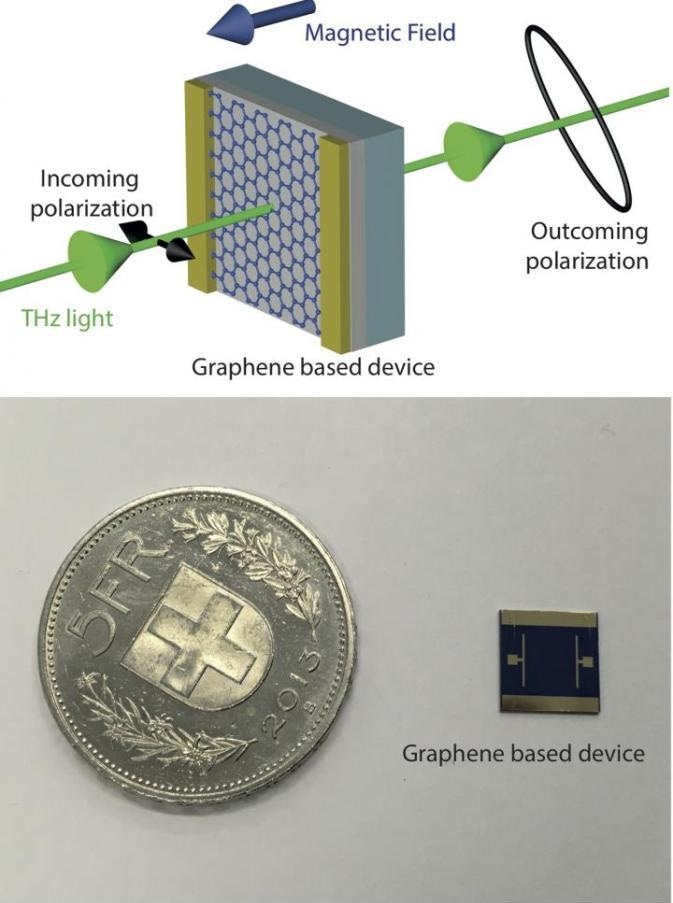Mar 8 2017
 Graphene based device is shown. (Credit - Copyright UNIGE)
Graphene based device is shown. (Credit - Copyright UNIGE)
The terahertz waves span frequency ranges between the infrared spectrum (used, for instance, for night vision) and gigahertz waves (which are used, among others applications, in Wi-Fi connections). Terahertz waves help to detect materials that are undetectable at other frequencies. However, the application of these waves is severely restricted due to the absence of appropriate materials and devices to control them.
A research team at the University of Geneva (UNIGE) collaborating with the Federal Polytechnic School in Zurich (ETHZ) and two Spanish research teams, has developed a method based on the utilization of graphene, which allows for the potentially very rapid control of both the polarization and the intensity of terahertz light.
This discovery has been reported in Nature Communications, and opens the door to practical use of terahertz waves, especially for telecommunications and imaging.
Graphene is a single atomic layer comprising of carbon atoms that form a honeycomb arrangement. It is found for instance in graphite, the chief constituent of pencil rods. Alexey Kuzmenko's team belonging to the Department of Quantum Matter Physics of UNIGE's Faculty of Sciences, has been involved in studying the physical properties of graphene for many years.
The interaction between terahertz radiation and the electrons in graphene is very strong and we have therefore come to the hypothesis that it should be possible to use graphene to manage terahertz waves.
Alexey Kuzmenko, UNIGE
Operating within the European project Graphene Flagship’s framework, researchers have built a graphene-based transistor adapted to terahertz waves. "By combining the electrical field, which enables us to control the number of electrons in graphene and thus allows more or less light to pass through, with the magnetic field, which bends the electronic orbits, we have been able to control not just the intensity of the terahertz waves, but also their polarisation," comments Jean-Marie Poumirol, a member of the UNIGE research team and the study’s first author.
"It is rare that purely electrical effects are used to control magnetic phenomena." Scientists can currently apply such control over a whole range of terahertz frequencies.
Practical applications of terahertz waves
The UNIGE research team is now eager to move on from the prototype, and create practical applications and new opportunities by manipulating terahertz waves. Their aim is to make terahertz waves industrially viable in the next couple of years. There are two key areas of application for this innovation - the first one is communications.
Using a film of graphene associated with terahertz waves, we should be potentially able to send fully-secured information at speeds of about 10 to 100 times faster than with Wi-Fi or radio waves, and do it securely over short distances.
Jean-Marie Poumiro, UNIGE
This would be a significant benefit in telecommunications. The second area of application is that of imaging. As terahertz waves are non-ionizing, they do not modify DNA and thus are very practical in biology, medicine, and pharmacy. Additionally, the control of the circular polarization of the terahertz waves will allow distinction between varied symmetries (right-handed or left-handed) of biological molecules, which is an extremely significant property in medical applications.
There is also a very promising and powerful application of these waves in homeland security.
Terahertz waves are stopped by metals and are sensitive to plastics and organic matter. This could lead to more effective means of detecting firearms, drugs and explosives carried by individuals, and could perhaps serve as a tool to strengthen airport safety.
Alexey Kuzmenko, UNIGE